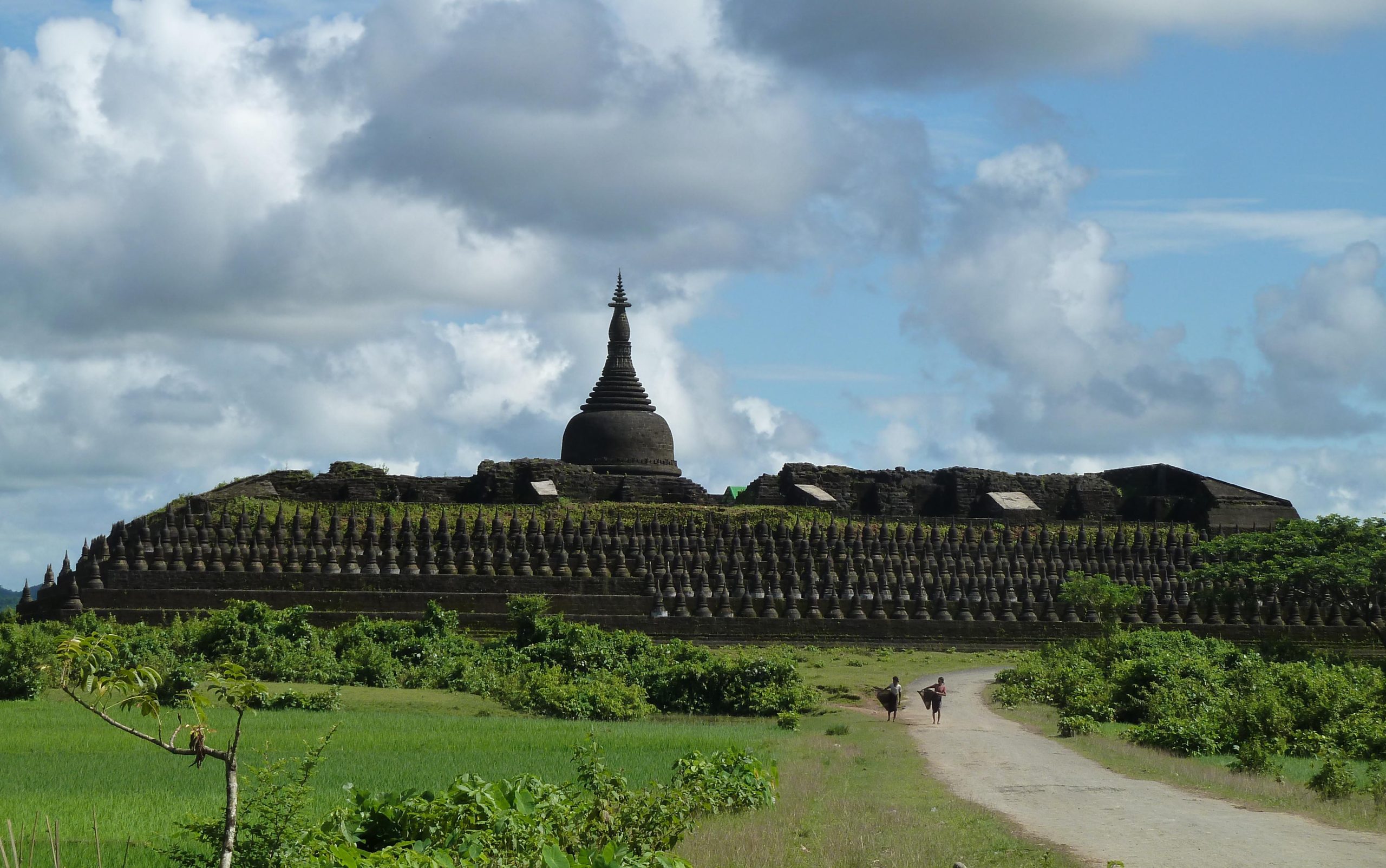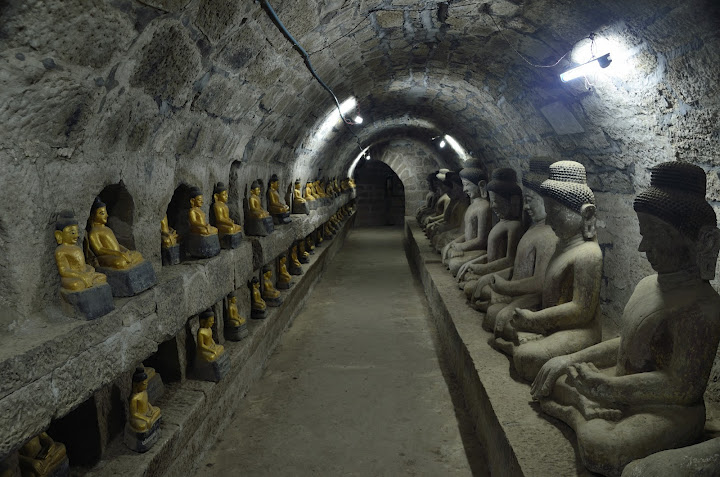
Mrauk-U is another interesting historical site in Rakhine, fast becoming a tourist attraction.
Mrauk-U was founded in 1430 AD and flourished till 1785 as recorded in its history. Known as the Golden City by foreign travelers of the era, it was a focus of trade due to its strategic position on the coastal region of the Bay of Bengal. There are many historical sites, such as the old palace grounds and ancient pagodas. Principally Shitthoung Pagoda (Eighty thousand pagodas), the old city of Vesali, the Mahamuni Image of Kyauktaw, offers a glimpse into the Rakhine state. A new tourist site, which is becoming increasingly popular in recent years, is the old capital of Rakhine (Arakan) called Mrauk-U. Some of the local people refer to it as Myo (or Mro) Haung, the old city. It was first constructed by the Rakhine King Min Saw Mon in 1430 AD, and remained its capital for 355 years until 1784.The Rakhine Kingdom ceased to exist as a separate entity and became an integral part of the Myanmar Kingdom. The Great Image is of course, the Maha Muni Buddha Image, which is now in Mandalay, though it was originally made and venerated in the area about 15 miles from Mrauk-U. Another Maha Muni Buddha Image flanked by two other Buddha images is now worshipped. There are innumerable pagodas and Buddha images all over the old city and the surrounding hills. Some are still being used as places of worship today. Many in ruins are now being restored to their original splendor. The most famous and well worth visiting are the Shitthaung, the Andaw, the Dukkhan Thein (Sima or Ordination Hall), the Kowthaung, the Laymyetnha and the Shwe Daung pagodas.
Archaeological Museum
The museum is situated near the Palace Site. This site is right in the center of Mrauk-U, which was built in a strategic location by leveling three small hills. Recently the Archaeology Department has been excavating the Palace Site, which was occupied by Rakhine Kings for over two hundred years. Even the pagodas are strategically located on hilltops and look like fortresses as indeed they were once used as such in times of enemy invasions. There are moats, artificial lakes, canals and the whole area could be flooded to deter or repulse attackers.
The Shitthaung or "temple of the 80,000 Buddhas"
The Shitthaung or “temple of the 80,000 Buddhas” is a fascinating place full of small images, scenes in sculpture of Buddhist stories. The kings and queens, countries and common people portrayed in their mediaeval costumes and head-dresses, all frozen in stone throughout the ages.
One should take a good torch light to examine the myriad interesting scenes and figures lining the dark corridors of this temple. One can see some Rakhine men boxing and wrestling, some girls dancing and playing, and then there are also the mythical birds, beasts and half-human celestials and demons. Try and find the figures of both the male and female Vasundhra / Vasundhari symbolizing the God / Goddess of the Earth. The Shitthaung Pagoda, located about half a mile to the north of the palace site was built by one of the most powerful kings of the Mrauk-U Dynasty, called by the people, Minbargyi. But according to records on inscriptions as King Minbin who reigned from 1513 to 1553. The king built this fortress-temple after repulsing a Portuguese attack. The Portuguese mercenaries later served under Rakhine kings. There was also surprisingly, an elite corps of Japanese bodyguards protecting the kings of Rakhine.
The Andaw (meaning the tooth relic of Buddha)
The Andaw is a pagoda only 86 feet to the northeast of the Shitthaung Pagoda. Built by King Min Hla Raza in 1521, it is said to enshrine the tooth relic received from Sri Lankan king by King Minbin. This temple is a hollow octagonal building make of pure sandstone blocks; there are two internal concentric passages, with a prayer hall on the east. Like other temples it is on a small hillock.
The Laymyetnha Pagoda
Laymyetnha Pagoda was built by King Min Saw Mon in 1430 AD as one of the original pagodas at the time of the founding of Mrauk-U. The name of the Pagoda means “Four faced” as there are four entrances to this square sandstone structure with a central solid stupa 80 feet high. There are 28 Buddha images as mentioned in the Sam Buddha scripture.
The Shwe Daung Pagoda or the "Golden Hill Pagoda"
The Shwe Daung Pagoda or the “Golden Hill Pagoda” is also believed to have been built by King Minbin between the years 1531-1553. It is a landmark pagoda as it is the tallest in this area and can be seen as far away as 20 miles from the main Kaladan River. The hill itself is 250 feet high and is about half a mile to the south-east of the Palace Site. It is a solid stupa with a circular base. During the First Anglo-Burmese War – 1824-26, the Myanmar forces built earthen fortifications on this hill and mounted guns, which inflicted heavy losses on the British forces. Some of these fortifications can still be seen today.
Koethaung Pagoda
Koethaung Pagoda, is standing amid the plain of rice fields. The name means 90,000 and probably signified the number of Buddha images it was supposed to contain. It was built by King Min Taikkha, the son of King Min Bin who built the Shitthaung or temple of 80,000 images. The son exceeded his father by 10,000! It is the biggest pagoda in the Mrauk-U area. Like the Shitthaung, this pagoda is also a massive fortress-like structure built with stonewalls and terraces. There are 108 smaller pagodas surrounding it, all made of sandstone. With a winding corridor it is like a cave tunnel. The inner gallery has collapsed and is no longer accessible. There is an octagonal pagoda in the middle surrounded by over one hundred smaller pagodas. Unlike some of the other temples, not only sandstone, but also bricks were also used in this
pagoda.
Htukkan Thein (Ordination Hall)
Htukkan Thein (Ordination Hall) is located about 300 feet to the north west of Shitthaung Pagoda. Built in 1571 by King Min Phalaung, it is on a hillock 30 feet high. Two stone stairways (8) feet broad on the east and south lead to the pagoda. No longer used as an Ordination Hall, it is now one of the well-known pagodas of Mrauk-U. There is a long vaulted passageway, which leads to the central shrine room, which is 15 feet in height. This room is said to be the place where the Chief Monk used to sit to discuss religious affairs with Senior Monks. In the seated stone, ladies preserving the ancient hair-styles, is among the many other interesting figures. There are also 140 niches with Buddha images.

